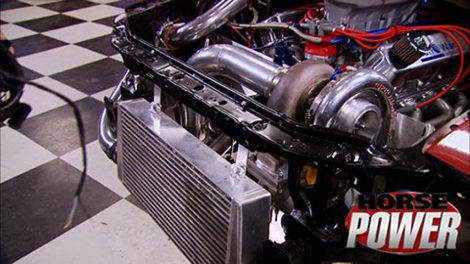HorsePower Builds
Want more content like this?
Join the PowerNation Email NewsletterParts Used In This Episode
Aerospace Components
2 Piston Floater Mustang Kits For 79-93 Mustangs. Aerospace Components 2 Piston Floater Mustang Kit's are designed for hub mount style wheels. This unique design allowes the front tires to be tucked under the car's fenders by an additional 1/4" over stock. But still provide adequate clampling forces to tame your speeding horse.
Aerospace Components
Aerospace Components offers a variety of high quality rear brake kits that provide maximum stopping power for virtually any car. Our brakes are 100% CNC machined from 6061 T-6 Billet Aluminum. These CNC machined brakes can withstand more pressure than any cast brake kit. All of our brake kits come with drilled heat-treated steel rotors, and everything you need for an easy installation.
Auto Meter
Boost-vacuum guage, oil pressure gauge, water temperature gauge, brake pressure gauge.
EBC Brakes
EBC Yellowstuff is an aramid fibre based brake compound with high brake effect form cold and is possibly one of the first ever compounds that can be used for street and track driving., Designed for premium street driving offering better brake effect up to 600°C (1100°F). Manufactured using premium disc blanks mentioned above, the unique wide aperture slots in the EBC sport rotor actually draw cool air under the pad during heavy braking and reduce brake temperatures whilst also helping r
Hughes Performance
Enhanced P/G case assembly, with bolt-on bell housing for small block Ford applications and Ford bolt pattern., PRO-IV Series convertor, block safety plate and flexplate.
Painless Performance
Race Car Kit/Competition/8 Circuit Wiring Kit, Kit Includes: Start, ignition, electric water pump, electric fan, electric fuel pump #1, electric fuel pump #2, lights, & accessories. Comes with 18 feet of wire per circuit, terminals, wire ties, fusible link, rubber grommet, and easy to follow instructions. 8 Switch Panel/Non-Fused/Dash Mount.
QA1
Mustang Pro-Active system includes tubular K-member, caster/camber plates, Mustang struts, coil-over kits with springs, tubular control arms, bump steer kit.
Roush Performance
This kit comes with a 2.3L TVS supercharger with black finish, upper and lower intake manifolds, an intercooler, a low temp radiator, a cold air intake system, a dual 60mm electronic throttle body, a unique fuel rail with 52 lb/hr fuel injectors.
Russell Performance
Billet Aluminum Y-Block w/ -10 AN inlet & -8 AN outlet (Blue finish), Russell ProRace hoses, Russell Full Flow Hose Ends, Russell Full Flow Swivel Hose Ends, Russell Cushion Clamps.
Summit Racing
CHEETAH SCS shifter with Black Gate Plate, Control Switch and Park/Neutral Start Switch. CHEETAH SCS shifter cover.
Dynotech Engineering Services
ChromeMoly 3.5" diameter custom length driveshaft with 1350 joints and weld yoke.
Hellion Power Systems
Turbonetics Turbocharger (88mm), 16 gauge Stainless Steel hot and cold parts (Mild Steel Headers), Spearco high flow air to air intercooler, High flow Turbonetics wastegate, Silicone hose kit, Stainless T-bolt clamp kit, 45 mm Blow-off valve, Oil feed and drain lines. All other necessary hardware to install kit.
High Performance Controls
The MFI system was designed from the ground up to provide a very simple and easy to understand tuning interface specifically for race only applications requiring very high fuel flow rates.
Holley
Form-A-Flex Radiator Hose Kit.
KGS Steel
1" X 1.5" 14 Gauge Rect. Tubing
Moroso
Front motor plate, mid-motor plate and engine limiter.
Napa Auto Parts
Tubing clamps (5)(5)
O'Reilly Auto Parts
Hayden electric fan.
O'Reilly Auto Parts
Hayden electric fan.
O'Reilly Auto Parts
Radiator Insulators
O'Reilly Auto Parts
Upper and lower radiator hoses
Performance Rod and Custom, Inc.
Extreme Duty Oil Cooler with -10AN fittings.
VFN Fiberglass
'87-'93 Ford Mustang fiberglass dash replacement.
Weldon Pumps
DB2025-A (-12 Inlet and -10 Outlet) Fuel Pump Controller Designed for EFI and Carb. applications, Billet Fuel Filter -- 40 Micron Filter with 12 AN O-ring ports, A2040 Series, Bypass Regulator





























